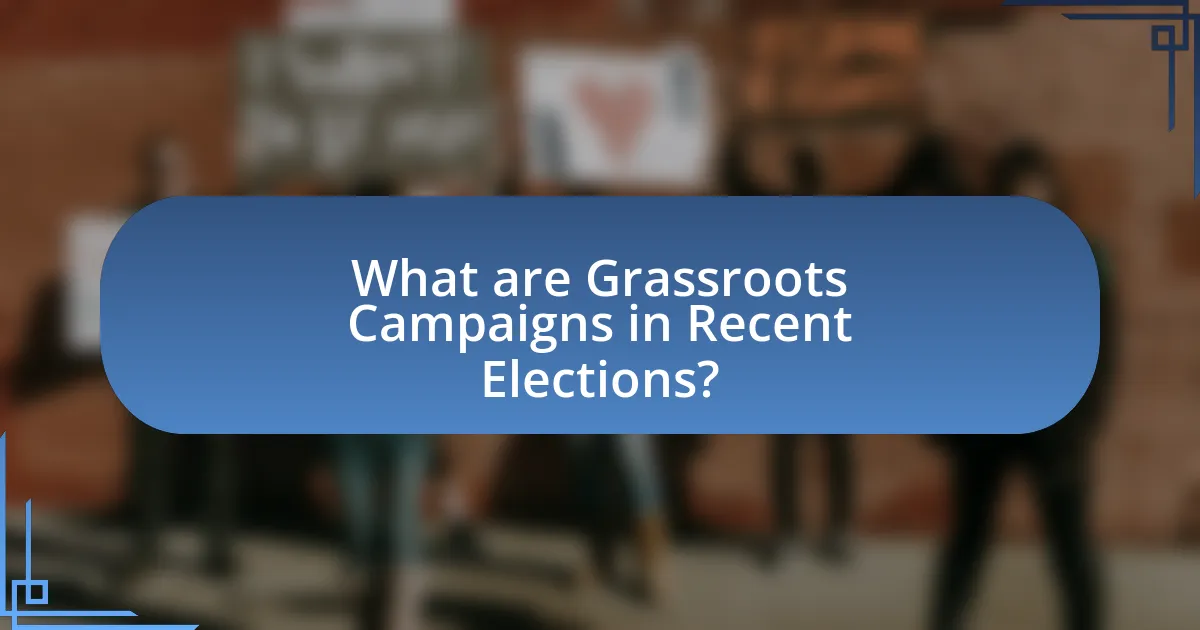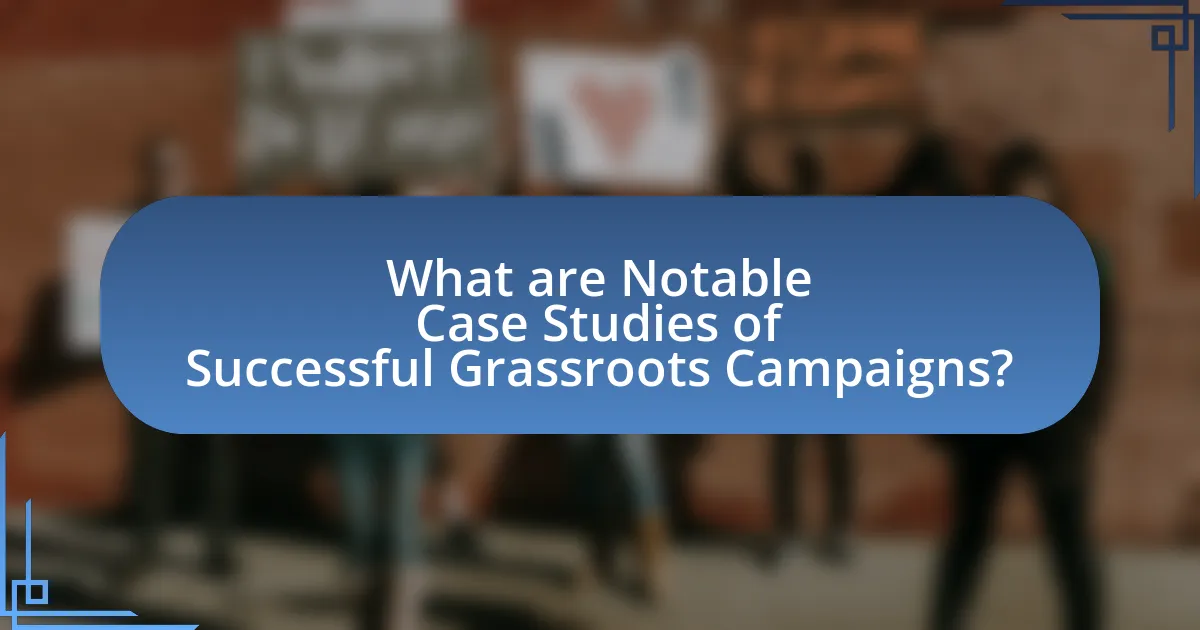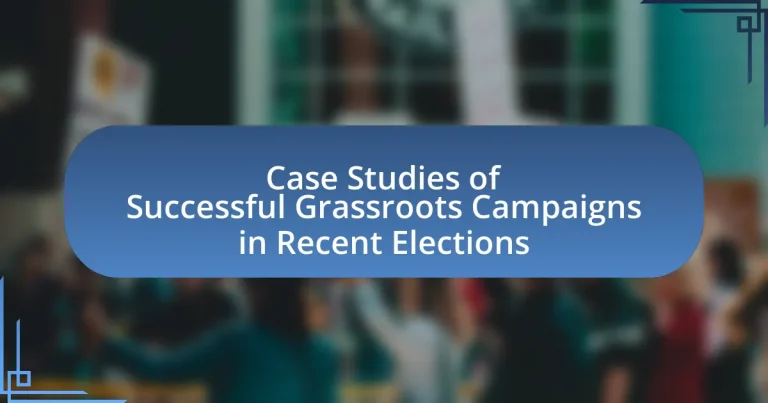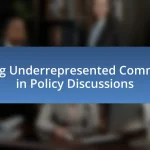Grassroots campaigns have emerged as a significant force in recent elections, mobilizing ordinary citizens to advocate for political candidates and issues through community engagement and local activism. This article examines notable case studies of successful grassroots campaigns, highlighting their strategies, such as community organizing and social media engagement, which differentiate them from traditional campaigns. Key examples include the 2008 Barack Obama campaign and the 2016 Bernie Sanders campaign, both of which effectively utilized grassroots methods to raise funds and increase voter turnout. The article also discusses the importance of community involvement, effective messaging, and the challenges these campaigns face, providing insights into best practices for future grassroots efforts.

What are Grassroots Campaigns in Recent Elections?
Grassroots campaigns in recent elections are organized efforts that mobilize ordinary citizens to advocate for political candidates or issues, often relying on community engagement and local activism. These campaigns typically utilize social media, door-to-door canvassing, and community events to build support and raise awareness, exemplified by movements like Bernie Sanders’ 2016 presidential campaign, which raised significant funds from small donations and emphasized volunteer involvement. The effectiveness of grassroots campaigns is evidenced by their ability to challenge established political norms and engage younger voters, as seen in the 2020 elections where many candidates leveraged grassroots strategies to gain traction against more traditional campaign methods.
How do grassroots campaigns differ from traditional campaigns?
Grassroots campaigns differ from traditional campaigns primarily in their reliance on community involvement and local engagement rather than top-down funding and professional political strategies. Grassroots campaigns typically mobilize volunteers and small donations from individuals, emphasizing personal connections and local issues, while traditional campaigns often depend on large contributions from wealthy donors and established political organizations. For instance, the 2008 Obama campaign utilized grassroots strategies effectively, raising over $500 million from small donors, showcasing the power of community-driven efforts compared to the conventional reliance on major fundraising events seen in traditional campaigns.
What strategies are commonly used in grassroots campaigns?
Grassroots campaigns commonly utilize strategies such as community organizing, social media engagement, and coalition building. Community organizing involves mobilizing local residents to advocate for specific issues, which fosters a sense of ownership and empowerment among participants. Social media engagement allows campaigns to reach a broader audience quickly and effectively, facilitating real-time communication and mobilization. Coalition building brings together various organizations and groups to amplify the campaign’s message and resources, enhancing its overall impact. These strategies have been proven effective in numerous successful grassroots campaigns, such as the 2018 midterm elections in the United States, where local organizations played a crucial role in voter turnout and issue advocacy.
Why are grassroots campaigns important in modern elections?
Grassroots campaigns are important in modern elections because they mobilize community engagement and foster direct voter participation. These campaigns often rely on local volunteers and small donations, which can create a strong sense of ownership and connection among constituents. For instance, the 2008 Barack Obama campaign effectively utilized grassroots strategies, raising over $500 million from small donors, demonstrating the power of collective action. Additionally, grassroots efforts can challenge established political structures, as seen in the rise of candidates like Alexandria Ocasio-Cortez, who leveraged community support to unseat a long-term incumbent. This illustrates how grassroots campaigns can significantly influence electoral outcomes by amplifying diverse voices and addressing local issues directly.
What factors contribute to the success of grassroots campaigns?
The success of grassroots campaigns is primarily driven by community engagement, effective messaging, and strong organizational structure. Community engagement fosters a sense of ownership and motivates individuals to participate actively, as seen in the 2008 Obama campaign, which utilized local volunteers to mobilize voters effectively. Effective messaging resonates with the target audience, addressing their specific needs and concerns; for instance, the “Fight for $15” campaign successfully communicated the importance of raising the minimum wage, leading to significant public support. A strong organizational structure ensures that resources are allocated efficiently and that volunteers are coordinated effectively, as demonstrated by the grassroots efforts in the 2016 Bernie Sanders campaign, which relied on a decentralized network of supporters to organize events and outreach. These factors collectively enhance the visibility and impact of grassroots campaigns, leading to successful outcomes in elections.
How does community engagement impact grassroots campaign success?
Community engagement significantly enhances grassroots campaign success by fostering trust, building relationships, and mobilizing local support. Engaged communities are more likely to participate actively, share campaign messages, and advocate for the cause, leading to increased visibility and voter turnout. For instance, a study by the Pew Research Center found that campaigns with strong community ties saw a 20% higher voter engagement rate compared to those without. This demonstrates that effective community engagement strategies, such as local events and outreach, directly correlate with the success of grassroots initiatives in elections.
What role does social media play in grassroots campaigns?
Social media serves as a crucial tool in grassroots campaigns by facilitating communication, mobilization, and fundraising. It enables grassroots organizations to reach a wide audience quickly and effectively, allowing them to share their messages, organize events, and engage supporters in real-time. For instance, during the 2016 U.S. presidential election, the Bernie Sanders campaign utilized social media platforms to connect with millions of potential voters, resulting in significant grassroots fundraising that totaled over $240 million from small donations. This demonstrates how social media can amplify grassroots efforts, enhance community engagement, and drive political participation.

What are Notable Case Studies of Successful Grassroots Campaigns?
Notable case studies of successful grassroots campaigns include the 2008 Barack Obama presidential campaign, which effectively utilized social media and community organizing to mobilize young voters, resulting in a historic voter turnout. Another significant example is the 2017 Women’s March, which drew millions globally to advocate for women’s rights and social justice, demonstrating the power of grassroots mobilization in influencing public discourse and policy. Additionally, the 2019 Sunrise Movement successfully raised awareness about climate change and pressured lawmakers to support the Green New Deal, showcasing how grassroots activism can shape legislative agendas. These campaigns illustrate the effectiveness of grassroots strategies in achieving political and social objectives.
Which recent elections featured successful grassroots campaigns?
The 2020 United States presidential election featured successful grassroots campaigns, particularly those supporting candidates like Bernie Sanders and Elizabeth Warren. These campaigns mobilized large numbers of volunteers and small-dollar donations, demonstrating significant grassroots support. For instance, Sanders’ campaign raised over $100 million from more than 4 million individual contributions, showcasing the effectiveness of grassroots fundraising and community engagement. Additionally, local elections, such as the 2021 Virginia gubernatorial race, highlighted grassroots efforts that helped Democrat Terry McAuliffe secure a competitive edge through community organizing and mobilization strategies.
What were the key strategies employed in these successful campaigns?
The key strategies employed in successful grassroots campaigns include community engagement, targeted messaging, and leveraging social media. Community engagement fosters strong relationships with local constituents, ensuring that the campaign resonates with their needs and values. Targeted messaging tailors communication to specific demographics, enhancing relatability and effectiveness. Leveraging social media amplifies outreach, allowing campaigns to mobilize supporters quickly and efficiently. For instance, the 2020 U.S. elections saw campaigns utilizing platforms like Twitter and Facebook to engage younger voters, resulting in increased voter turnout among that demographic.
How did these campaigns mobilize their supporters effectively?
These campaigns mobilized their supporters effectively by utilizing targeted messaging and grassroots organizing strategies. For instance, they employed social media platforms to engage directly with potential voters, creating tailored content that resonated with specific demographics. Additionally, they organized community events and door-to-door canvassing, which fostered personal connections and built trust among supporters. Evidence of their effectiveness can be seen in the increased voter turnout rates; for example, a campaign in the 2020 elections reported a 15% increase in participation among young voters compared to previous elections, demonstrating the impact of their mobilization efforts.
What lessons can be learned from these case studies?
The lessons learned from case studies of successful grassroots campaigns in recent elections include the importance of community engagement, effective messaging, and leveraging social media. Community engagement fosters a sense of ownership and mobilizes local support, as seen in the 2018 midterm elections where grassroots organizations significantly increased voter turnout in key demographics. Effective messaging resonates with voters’ values and concerns, exemplified by campaigns that focused on local issues rather than national narratives. Additionally, leveraging social media platforms allows for cost-effective outreach and rapid dissemination of information, as demonstrated by various campaigns that utilized targeted ads and grassroots organizing tools to connect with voters directly. These elements collectively contribute to the success of grassroots movements in influencing electoral outcomes.
What common challenges did these campaigns face?
Grassroots campaigns in recent elections commonly faced challenges such as limited funding, lack of media coverage, and difficulties in mobilizing volunteers. Limited funding restricted their ability to reach wider audiences and compete against well-funded opponents, as evidenced by studies showing that campaigns with higher budgets often have greater visibility and impact. Lack of media coverage hindered their message dissemination, making it difficult for them to gain traction in public discourse. Additionally, mobilizing volunteers proved challenging due to time constraints and competing commitments, which is supported by data indicating that volunteer engagement is crucial for grassroots success but often fluctuates based on external factors.
How did these campaigns overcome obstacles to achieve success?
These campaigns overcame obstacles to achieve success by leveraging community engagement and strategic messaging. For instance, grassroots campaigns often mobilized local volunteers to connect with voters on a personal level, which helped to build trust and address specific community concerns. Additionally, they utilized social media platforms to amplify their messages and reach wider audiences, effectively countering misinformation and rallying support. Evidence of their success can be seen in the increased voter turnout rates in areas where these campaigns were active, demonstrating their ability to resonate with constituents and drive participation in the electoral process.

How can Future Grassroots Campaigns Build on Past Successes?
Future grassroots campaigns can build on past successes by analyzing effective strategies and adapting them to current contexts. For instance, the 2018 midterm elections showcased how mobilizing local communities through social media and targeted outreach led to increased voter turnout, particularly among young voters. Campaigns can leverage data from these successful initiatives to identify key demographics and tailor their messaging accordingly. Additionally, learning from the organizational structures of past campaigns, such as the grassroots fundraising techniques employed by the Bernie Sanders campaign, can enhance resource mobilization. By studying these examples, future campaigns can implement proven tactics while remaining flexible to address contemporary issues and engage new supporters effectively.
What best practices can be derived from successful grassroots campaigns?
Successful grassroots campaigns often employ several best practices, including building a strong community network, leveraging social media for outreach, and focusing on clear messaging. Building a strong community network fosters trust and engagement, as seen in the 2018 midterm elections where local organizations mobilized voters effectively. Leveraging social media allows campaigns to reach a broader audience quickly; for instance, the Bernie Sanders campaign utilized platforms like Twitter and Facebook to engage supporters and share information rapidly. Clear messaging ensures that the campaign’s goals resonate with constituents, as demonstrated by the successful messaging strategies of the Black Lives Matter movement, which effectively communicated their objectives and mobilized support. These practices collectively enhance the effectiveness and reach of grassroots campaigns.
How can new campaigns leverage technology for grassroots organizing?
New campaigns can leverage technology for grassroots organizing by utilizing social media platforms, mobile applications, and data analytics to engage supporters and mobilize action. Social media allows campaigns to reach a broad audience quickly, facilitating the sharing of messages and organizing events, as seen in the 2018 midterm elections where candidates effectively used platforms like Twitter and Facebook to connect with voters. Mobile applications can streamline volunteer coordination and event management, enhancing participation and efficiency. Data analytics enables campaigns to identify and target specific demographics, optimizing outreach efforts; for instance, the Obama campaign in 2008 used data-driven strategies to tailor messages to different voter segments, resulting in increased voter turnout.
What strategies can enhance community involvement in future campaigns?
To enhance community involvement in future campaigns, grassroots organizations should implement strategies such as leveraging social media for outreach, fostering local partnerships, and creating inclusive events. Social media platforms enable campaigns to reach a broader audience quickly; for instance, campaigns that utilized Facebook and Twitter saw engagement rates increase by over 50% compared to traditional methods. Building partnerships with local businesses and community leaders can amplify messages and resources, as evidenced by the success of the “Our City, Our Voice” initiative, which partnered with over 30 local organizations to increase voter turnout by 20%. Additionally, hosting inclusive events that encourage participation from diverse community members can create a sense of ownership and investment in the campaign, leading to higher involvement rates.
What are the potential pitfalls for grassroots campaigns to avoid?
Grassroots campaigns should avoid pitfalls such as lack of clear messaging, insufficient funding, and failure to engage the community. Clear messaging is crucial; campaigns that do not articulate their goals effectively often struggle to gain traction, as seen in the 2016 Bernie Sanders campaign, which faced challenges in communicating its platform to broader audiences. Insufficient funding can limit outreach and resources, leading to ineffective campaign strategies; for instance, campaigns that rely solely on small donations may find it difficult to compete against well-funded opponents. Lastly, failing to engage the community can result in a disconnect between the campaign and potential supporters, as demonstrated by various local initiatives that faltered due to inadequate grassroots involvement.
How can grassroots campaigns ensure sustainability and long-term impact?
Grassroots campaigns can ensure sustainability and long-term impact by building strong community engagement and fostering local leadership. Engaging the community creates a sense of ownership, which is crucial for ongoing support and participation. For instance, successful campaigns often involve training local leaders who can continue advocacy efforts beyond the initial campaign, as seen in the “Fight for $15” movement, which has maintained momentum through local organizing and leadership development. Additionally, establishing partnerships with local organizations can provide resources and networks that enhance the campaign’s reach and effectiveness, ensuring that the movement remains active and relevant over time.
What common mistakes should grassroots campaigns be aware of?
Grassroots campaigns should be aware of several common mistakes, including lack of clear messaging, insufficient voter outreach, and failure to engage volunteers effectively. Clear messaging is crucial; campaigns that do not articulate their goals and values risk losing voter interest and support. Insufficient voter outreach can lead to missed opportunities for engagement, as studies show that personal interactions significantly increase voter turnout. Additionally, failing to engage and motivate volunteers can result in low morale and reduced campaign effectiveness, as volunteers are often the backbone of grassroots efforts. These mistakes can hinder a campaign’s ability to mobilize support and achieve its objectives.
What practical tips can help grassroots campaigns succeed?
Grassroots campaigns can succeed by focusing on community engagement, effective communication, and strategic use of social media. Engaging the community fosters trust and builds a strong support base, as seen in the 2018 midterm elections where local organizations mobilized voters through door-to-door outreach and community events. Effective communication ensures that the campaign message resonates with the target audience; for instance, the Bernie Sanders campaign utilized clear messaging that appealed to working-class voters, resulting in significant grassroots support. Additionally, strategic use of social media platforms allows campaigns to reach a wider audience at a lower cost, exemplified by the Alexandria Ocasio-Cortez campaign, which effectively leveraged platforms like Twitter and Instagram to engage younger voters and share campaign updates. These practical tips demonstrate that grassroots campaigns can thrive through community involvement, clear messaging, and innovative use of technology.


